PCsound ParaGraf electronic secretary, or how the office was automated in 1992
Greetings, my dear lovers of old iron!

Recently , an amusing little thing fell into my hands - the Electronic Secretary PCsound , which has been produced in Russia since 1991.
This device was developed by ParaGraf , and Axion took over the production of finished products .
What is interesting about this unit, you ask? Yes, even the fact that it was created on the domestic element base, it began to be released in very difficult times for our country, and, most interestingly, the electronic secretary was connected to a personal computer and had many functions and capabilities that would appeal to many potential to buyers.
But first things first!
Description.
Electronic Secretary (hereinafter referred to as ES) is a complex of software and hardware for personal computers, designed to work with the telephone network, record and play sound.
The name was not chosen by chance. The Electronic Secretary at the right time reminds you of important matters, calls at the specified time on the specified phone and transmits your messages, while recording the response of the subscriber, which you can listen to at a convenient time for you.

Using ES significantly expands the capabilities of your phone. The last 9 phone numbers you dialed are automatically remembered. You can record the most important phone conversations and then play them back.
At your disposal is always an electronic notebook in which you can easily and quickly find any entry.
In addition, you will receive a telephone answering machine that will determine the phone number of the person calling you, and in your absence will answer the phone, record the messages received and transmit them to the number you specified. If you have a tone dialing device, then, being in a different place, you can call the ES, listen to the messages recorded by the answering machine and report the phone number by which they should be transmitted in the future.
In addition, the ES performs all the functions associated with the reception and transmission of fax messages.
If you are engaged in the creation of voiced programs (games, training complexes, music programs), then ES will come in handy for you. The sound prepared with it can be used not only when working with the phone, but also in your programs. To do this, refer to the function library, which is part of the ES. It is necessary to take into account the fact that you can use the internal speaker of the computer.
System requirements.
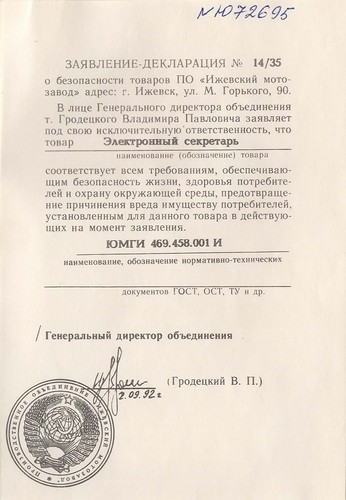
Computer running MS-DOS
IBM personal computer (models: АТ or PS / 2) or IBM-compatible
Disks
Hard disk and drive for 3.5 'or 5.25 ”floppy disks
Monitor and video
adapter Enhanced Graphics Adapter (EGA) or Video Graphics Array (VGA)
Disk Memory
When installing the complex, you must have free 2.4 MB.
Parallel port
LPT1 or LPT2
Minimum RAM
When starting the ES, 250 KB of RAM should be free.
Operating system
MS-DOS 3.3 or older versions
Components.
The PCsound ParaGraf electronic secretary was delivered in a rather large cardboard box, inside of which there is:
The instruction manual is written in Russian and contains illustrations. A set of 5 five-inch floppy disks with software is packaged in a separate cardboard box with color printing.
The date of manufacture of my copy is 10/30/1992.
Appearance.
The case of the electronic secretary is made of aluminum and painted with powder paint.
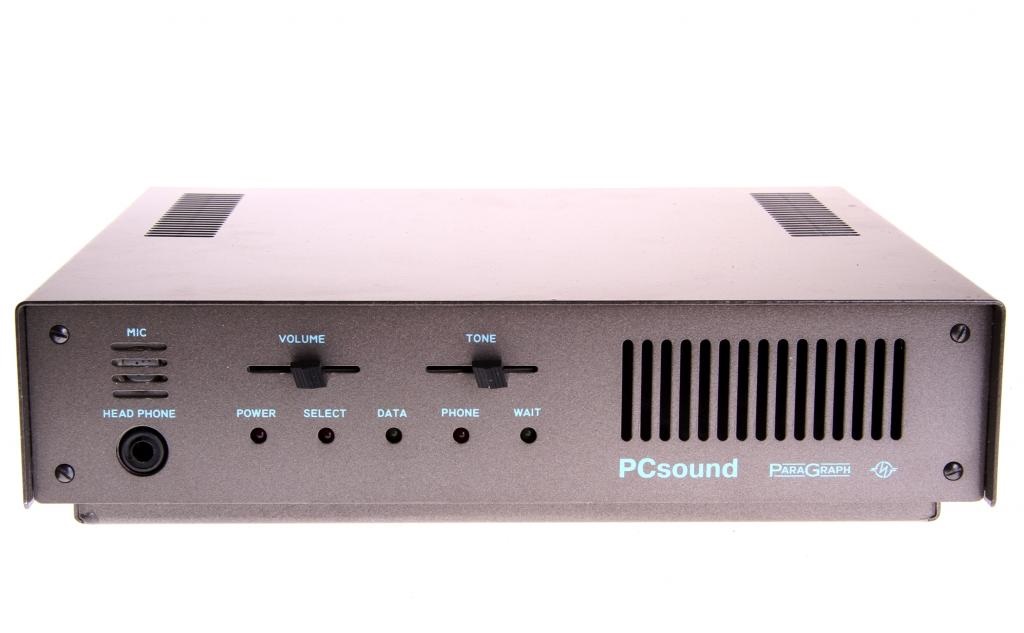
At the front are the volume and tone controls, a microphone, a headphone jack and LEDs to indicate the operation of the device. Behind the "bars" on the right side is a fairly loud speaker.

On the sides of the case, as well as on top, there are ventilation holes. Cooling inside the case is passive.

Hardware Description
The hardware of the ES is called PCsound-Dev - this is a small-sized console connected to the standard parallel port of a computer. The appearance of the console in front is shown in Fig. 1.1, and at the back - in fig. 1.2.

Fig. 1.1.
1 — built-in microphone; 2 — volume control; 3 — tone control;
4 — built-in speaker; 5 — headphone jack; 6 — power on indicator; 7 — device activity indicator; 8 — indicator of data exchange with a computer; 9 — power on indicator; 10 — indicator of waiting for a phone call.
PCsound-Dev is used for recording to a computer's hard drive and then playing back audio signals. These signals can be received from the built-in or external microphone and line input and played back to the built-in or external speaker (speaker system) or through an external amplifier.
PCsound-Dev is paired with a telephone line, allowing you to use it as a fax machine and a remotely controlled answering machine.
On the front panel there are two potentiometers that control the volume and timbre of sound, as well as LEDs to indicate the presence of power, connection to the ONLINE mode, the presence of information on the line.
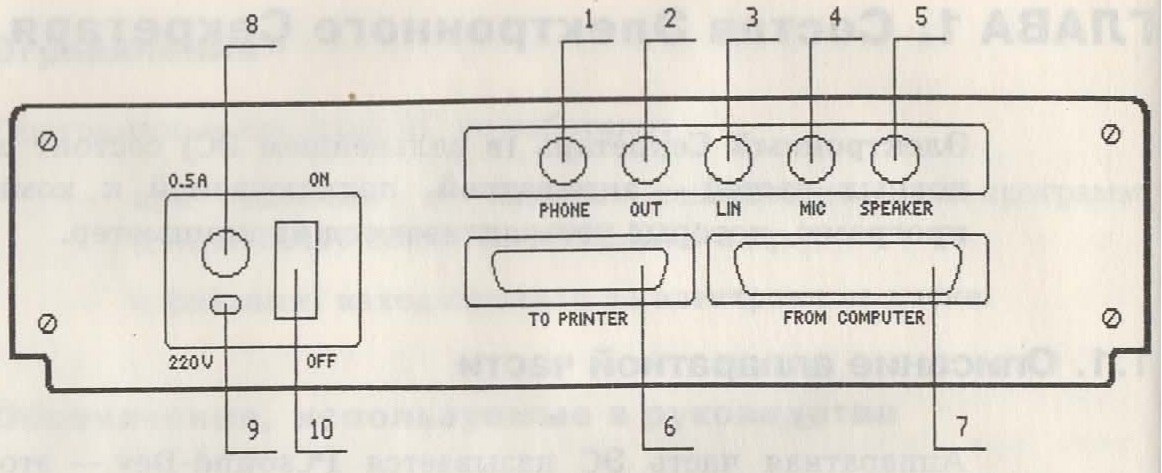
Fig. 1.2.
1 — jack for connecting to a telephone line; 2 — line out jack; 3 — line in jack; 4 — jack for connecting an external microphone; 5 — socket ”for connecting an external speaker system; b — a connector for connecting a printer; 7 — connector for connecting to a computer; 8 — mains fuse (0.5A); 9 — power cord; 10 — on / off toggle switch.
Software.
Do not forget that the PCsound Electronic Secretary is part of the hardware and software complex, and without appropriate software it is a high-tech stand for a hot pan.
The software part of the Electronic Secretary is called PCsound-Soft - it is a set of software tools installed on the computer's hard drive. PCsound-Soft allows your computer to work with PCsound-Dev. The composition of PCsound-Soft includes the following components:
1. PCsound-Studio - a set of programs for recording, processing and playback of audio signals.
2. PCsound-Phone - a set of programs for working with a telephone line.
3. PCsound-Res - a set of programs for working with sound in the background.
4. PCsound-Lib - a set of programs for including sound in the programs you create.
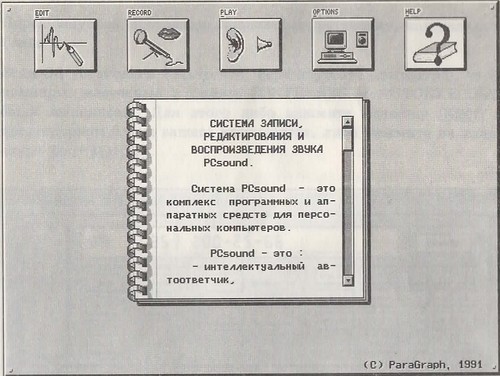
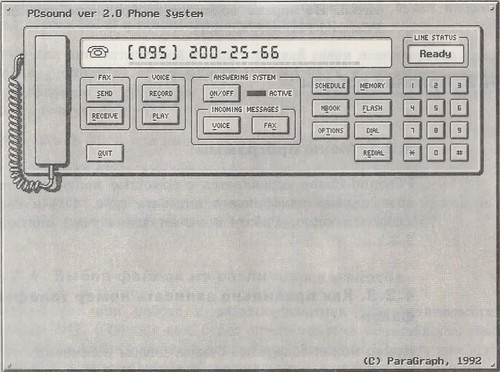
A copy of the contents of the installation floppy disks can be downloaded here , what if it comes in handy?) The
internal device.
The electronic secretary is entirely assembled from domestic components, this can be seen in the photo below:

The main modules (and there are only three of them) are mounted on the chassis and interconnected via detachable connections SNP 58-64.
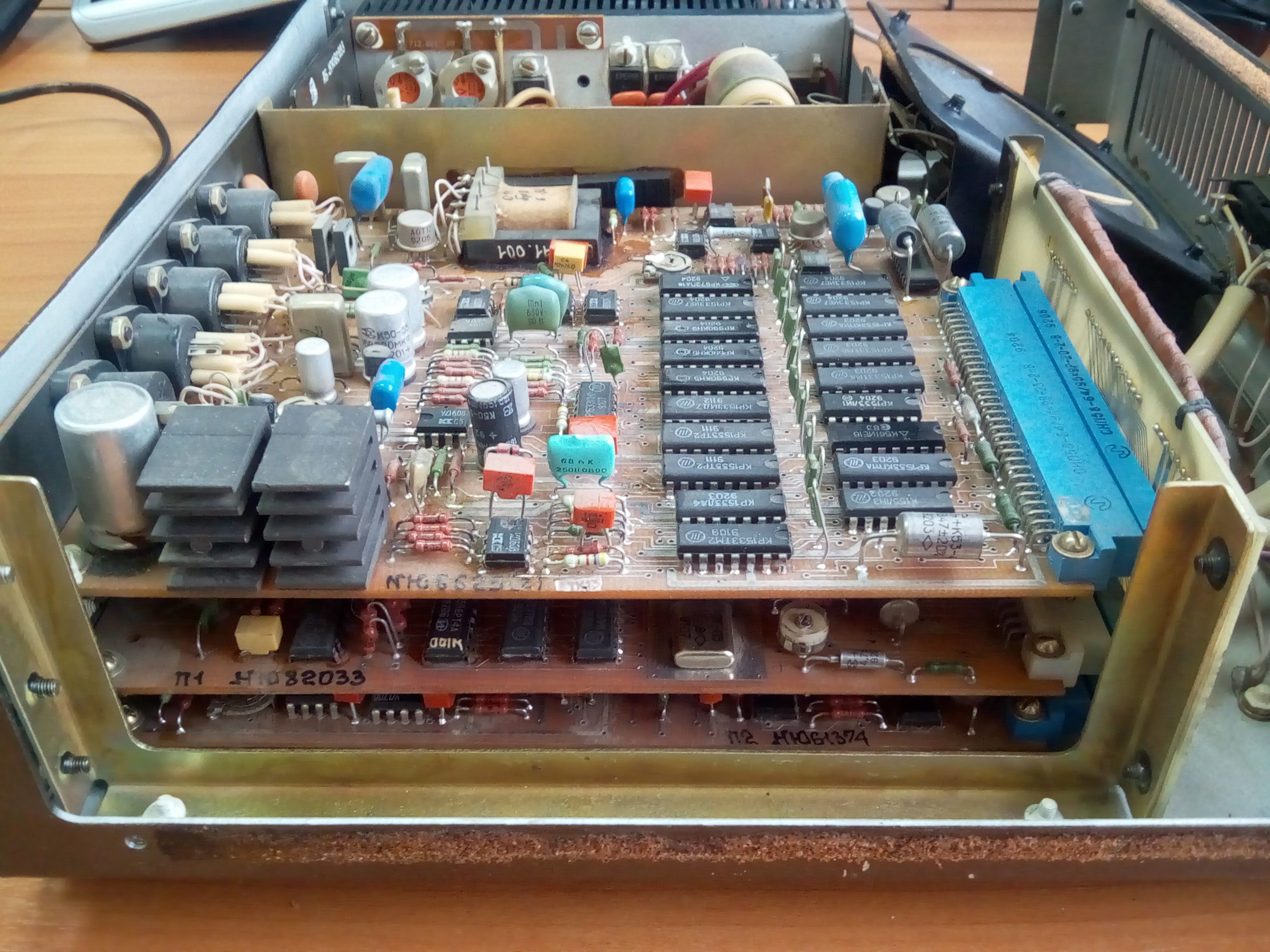
The transformer power supply still works fine, regardless of age. And if you suddenly still want to repair it, caring designers will prudently share the Rose alloy with you over decades!

The developers wanted to make a truly reliable device, and whenever possible used the most reliable components at that time, for example, the 1533 series microcircuits.

The first module in a triple sandwich of boards is responsible for working with external sound sources and a telephone line.
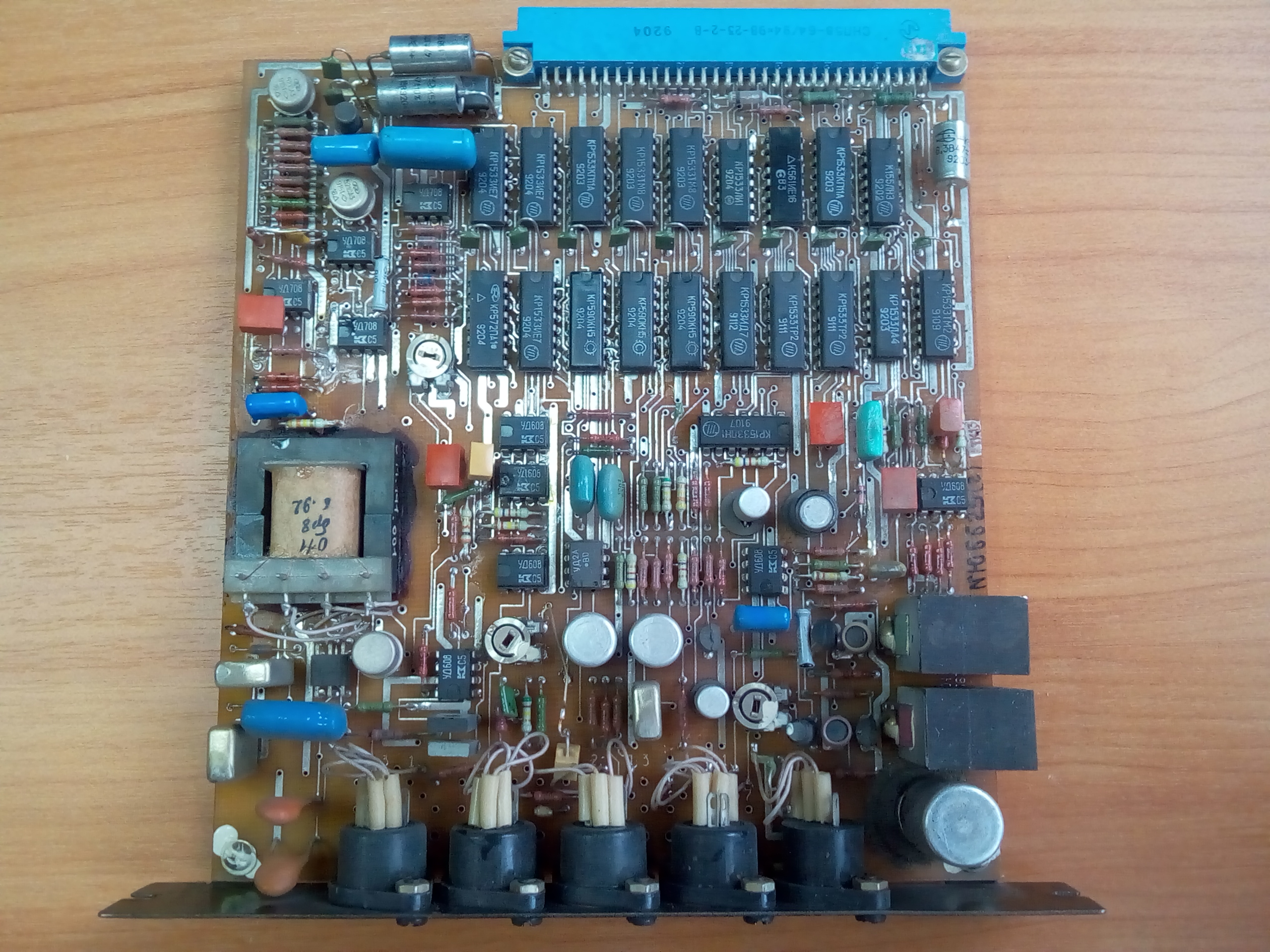
On the second board there is a harness for working with the interface LPT port and the printer port. Particular attention should be paid to the presence of RAM chips KR537RU10 and ROM KR556RT17.

On the lowest board you can find the KR573RF5 ROM chip, the only gold-plated chip in the entire device, a bunch of UD708 operational amplifiers, a small amount of fine logicand three dried cockroaches with a quality mark on the belly .

The case with the removed modular boards looks pretty impressive. Still, the use of aluminum, and not cheap plastic, looks stern and Soviet!

That's my story about PCsound ParaGraf electronic secretaryover. I hope that among the readers of Giktayms there are people who can tell in the comments about this device and its history, as well as about the fate of ParaGraf and the Izhevsk Motor Works in those difficult years for the country.

Recently , an amusing little thing fell into my hands - the Electronic Secretary PCsound , which has been produced in Russia since 1991.
This device was developed by ParaGraf , and Axion took over the production of finished products .
What is interesting about this unit, you ask? Yes, even the fact that it was created on the domestic element base, it began to be released in very difficult times for our country, and, most interestingly, the electronic secretary was connected to a personal computer and had many functions and capabilities that would appeal to many potential to buyers.
But first things first!
Description.
Electronic Secretary (hereinafter referred to as ES) is a complex of software and hardware for personal computers, designed to work with the telephone network, record and play sound.
The name was not chosen by chance. The Electronic Secretary at the right time reminds you of important matters, calls at the specified time on the specified phone and transmits your messages, while recording the response of the subscriber, which you can listen to at a convenient time for you.

Using ES significantly expands the capabilities of your phone. The last 9 phone numbers you dialed are automatically remembered. You can record the most important phone conversations and then play them back.
At your disposal is always an electronic notebook in which you can easily and quickly find any entry.
In addition, you will receive a telephone answering machine that will determine the phone number of the person calling you, and in your absence will answer the phone, record the messages received and transmit them to the number you specified. If you have a tone dialing device, then, being in a different place, you can call the ES, listen to the messages recorded by the answering machine and report the phone number by which they should be transmitted in the future.
In addition, the ES performs all the functions associated with the reception and transmission of fax messages.
If you are engaged in the creation of voiced programs (games, training complexes, music programs), then ES will come in handy for you. The sound prepared with it can be used not only when working with the phone, but also in your programs. To do this, refer to the function library, which is part of the ES. It is necessary to take into account the fact that you can use the internal speaker of the computer.
System requirements.

Computer running MS-DOS
IBM personal computer (models: АТ or PS / 2) or IBM-compatible
Disks
Hard disk and drive for 3.5 'or 5.25 ”floppy disks
Monitor and video
adapter Enhanced Graphics Adapter (EGA) or Video Graphics Array (VGA)
Disk Memory
When installing the complex, you must have free 2.4 MB.
Parallel port
LPT1 or LPT2
Minimum RAM
When starting the ES, 250 KB of RAM should be free.
Operating system
MS-DOS 3.3 or older versions
Components.
The PCsound ParaGraf electronic secretary was delivered in a rather large cardboard box, inside of which there is:
- PCsound ParaGraf Electronic Secretary
- User's manual
- Interface and connection cables
- Software kit on 5 floppy disks
- Two spare fuses
The instruction manual is written in Russian and contains illustrations. A set of 5 five-inch floppy disks with software is packaged in a separate cardboard box with color printing.
The date of manufacture of my copy is 10/30/1992.
Appearance.
The case of the electronic secretary is made of aluminum and painted with powder paint.

At the front are the volume and tone controls, a microphone, a headphone jack and LEDs to indicate the operation of the device. Behind the "bars" on the right side is a fairly loud speaker.

On the sides of the case, as well as on top, there are ventilation holes. Cooling inside the case is passive.

Hardware Description
The hardware of the ES is called PCsound-Dev - this is a small-sized console connected to the standard parallel port of a computer. The appearance of the console in front is shown in Fig. 1.1, and at the back - in fig. 1.2.

Fig. 1.1.
1 — built-in microphone; 2 — volume control; 3 — tone control;
4 — built-in speaker; 5 — headphone jack; 6 — power on indicator; 7 — device activity indicator; 8 — indicator of data exchange with a computer; 9 — power on indicator; 10 — indicator of waiting for a phone call.
PCsound-Dev is used for recording to a computer's hard drive and then playing back audio signals. These signals can be received from the built-in or external microphone and line input and played back to the built-in or external speaker (speaker system) or through an external amplifier.
PCsound-Dev is paired with a telephone line, allowing you to use it as a fax machine and a remotely controlled answering machine.
On the front panel there are two potentiometers that control the volume and timbre of sound, as well as LEDs to indicate the presence of power, connection to the ONLINE mode, the presence of information on the line.

Fig. 1.2.
1 — jack for connecting to a telephone line; 2 — line out jack; 3 — line in jack; 4 — jack for connecting an external microphone; 5 — socket ”for connecting an external speaker system; b — a connector for connecting a printer; 7 — connector for connecting to a computer; 8 — mains fuse (0.5A); 9 — power cord; 10 — on / off toggle switch.
Software.
Do not forget that the PCsound Electronic Secretary is part of the hardware and software complex, and without appropriate software it is a high-tech stand for a hot pan.
The software part of the Electronic Secretary is called PCsound-Soft - it is a set of software tools installed on the computer's hard drive. PCsound-Soft allows your computer to work with PCsound-Dev. The composition of PCsound-Soft includes the following components:
1. PCsound-Studio - a set of programs for recording, processing and playback of audio signals.
2. PCsound-Phone - a set of programs for working with a telephone line.
3. PCsound-Res - a set of programs for working with sound in the background.
4. PCsound-Lib - a set of programs for including sound in the programs you create.


A copy of the contents of the installation floppy disks can be downloaded here , what if it comes in handy?) The
internal device.
The electronic secretary is entirely assembled from domestic components, this can be seen in the photo below:

The main modules (and there are only three of them) are mounted on the chassis and interconnected via detachable connections SNP 58-64.

The transformer power supply still works fine, regardless of age. And if you suddenly still want to repair it, caring designers will prudently share the Rose alloy with you over decades!

The developers wanted to make a truly reliable device, and whenever possible used the most reliable components at that time, for example, the 1533 series microcircuits.

The first module in a triple sandwich of boards is responsible for working with external sound sources and a telephone line.

On the second board there is a harness for working with the interface LPT port and the printer port. Particular attention should be paid to the presence of RAM chips KR537RU10 and ROM KR556RT17.

On the lowest board you can find the KR573RF5 ROM chip, the only gold-plated chip in the entire device, a bunch of UD708 operational amplifiers, a small amount of fine logic

The case with the removed modular boards looks pretty impressive. Still, the use of aluminum, and not cheap plastic, looks stern and Soviet!

That's my story about PCsound ParaGraf electronic secretaryover. I hope that among the readers of Giktayms there are people who can tell in the comments about this device and its history, as well as about the fate of ParaGraf and the Izhevsk Motor Works in those difficult years for the country.
